Terry Laughlin's Blog, page 4
August 9, 2019
VIDEO: Why Synch Swim? Terry Laughlin and Shinji Takeuchi Demo This Practice
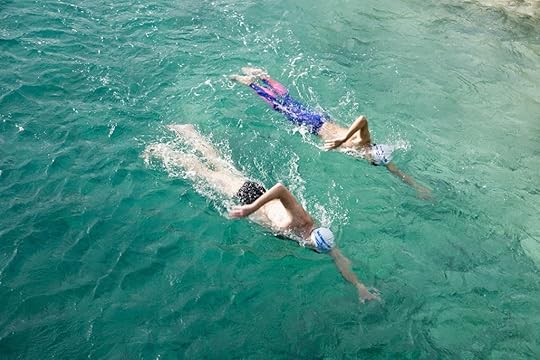
(Terry Laughlin and Shinji Takeuchi synch-swimming– Eleuthera, the Bahamas, December 2006.)
This post was originally published by Terry Laughlin on Feb. 12, 2011.
At the bottom of this post is video of Shinji [T.I. Master Coach and Head of TI Japan– read Shinji’s T.I. story in this 2012 blog interview] and I “synch-swimming” at TI Teacher Training in December 2010. Here I’ll focus on WHY we practice Synch-Swimming.
Synch-Swimming started as an exercise I came up with about 10 years ago [circa 2001 at the time of this writing] to practice with friends (including TI Coaches Dave Barra, Greg Sautner and Hash al-Mashat) at Lake Minnewaska in New Paltz. At first we just practiced swimming two to six swimmers abreast along the 200-meter line, as a pacing exercise. Then we tried to squeeze the group as close together as possible, until our hands and forearms — and occasionally hips and shoulders — were brushing lightly as we stroked.
We did this to simulate both the not-infrequent crowding and occasional physical contact of open water races. Our goal was to make this experience something we could accept, then even welcome. While most swimmers shy away from, or become anxious or distracted in such situations, we enjoyed it and were able to turn it into an aid to concentration.
Finally, we began trying to synchronize our strokes. This last piece was the icing on the cake. The experience of concentrating on your own stroke, while also being aware of other swimmers’ strokes — adjusting position, direction, length and tempo to theirs — proved so engrossing that we all experienced a powerful “swimmer’s high” in these practices. Synch-Swimming was so enjoyable and valuable it became a central and distinguishing feature of all TI Open Water camps.
Now I try to synch-swim with every TI Coach– and many TI swimmers– I have the opportunity to swim with, in open water or the pool.
This video shows two forms: In Synch-Swimming, you match the timing of right-arm to right-arm. In Mirror-Swimming, you match the timing of the inside arms. Enjoy!
Editorial Note: To view Terry and Shinji’s archived 2011 discussion forum Q &A about this synch swim video, click HERE.
Learn how to synch swim and other open water skills– including drafting, sighting, pacing, pack swimming, and more– in our video “Outside the Box: A Total Immersion Swimming Program for Success in Open Water”
The post VIDEO: Why Synch Swim? Terry Laughlin and Shinji Takeuchi Demo This Practice appeared first on Total Immersion.
August 2, 2019
Freestyle Breathing 101: Master the Mechanics
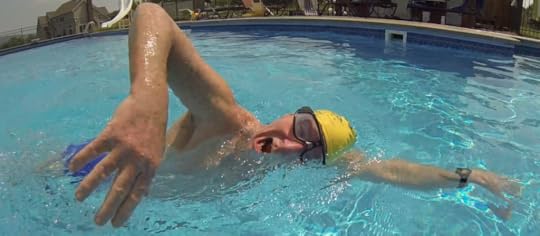
The following post is adapted from a 2006 article written by Terry Laughlin.
Richard Quick, the six-time U.S. Olympic team coach who directed 12 teams to NCAA titles, once said while giving a butterfly stroke clinic: “Don’t hide your breathing mistakes by not breathing; fix them instead.” That’s good advice, not only for butterfly, but for freestyle as well.
About 30 years ago, “hypoxic training” came into vogue. The idea was that by restricting breathing frequency—breathing every five, seven or nine freestyle strokes—swimmers might simulate the effects of high-altitude training at sea level.
Researchers long ago debunked the idea that breath-holding produces any physiological adaptation, but “hypoxic” sets are still popular, in part to help swimmers adjust to the discomfort produced when you reduce breathing frequency.
One reason for making that adjustment is the very real concern that in a sprint race, breathing can slow a swimmer down. If each breath might cost you slightly in stroke efficiency, the less of them you take, the faster you might go.
Holding your breath—perhaps breathing only twice or less—in a 50-yard freestyle undoubtedly helps your speed, particularly because that race is short enough that your muscles mainly consume oxygen already in your bloodstream.
But when racing for, say, 45 seconds to over a minute, you need to get fresh oxygen to your muscles. Because of this, holding your breath could restrict your ability to finish such races strongly. The ideal would be to be able to breathe as often as you want, without sacrificing any speed.
The key to maximizing both air and speed is to breathe as seamlessly as possible. Let’s start with the mechanics of getting air into your lungs:
Inhale through your mouth; exhale through your mouth 70 percent and nose 30 percent. Are these figures exact? No, just keep enough air pressure coming from your nose to keep the water out, especially as you roll to the surface and then return face-down.
Never hold your breath—even if you’ll swim three to five strokes between breaths. To avoid an uncomfortable build-up of CO2, begin exhaling as soon as you finish inhaling—just exhale in a more steady, controlled way if you’ll take more strokes before your next breath. You’ll need to manage your release of air with slow bubbles to sustain you comfortably until your next inhale.
As you roll to air, exhale the final 20 percent of air more forcefully than the first 80 percent. This should make the inhale which follows almost effortless by creating a vacuum in your lungs. It also helps clear the water away from your mouth for the next breath. Also, the force of your exhale should be proportionate to your effort. The next time you swim a descending set, experiment with consciously adding some force to your exhale as you go faster.
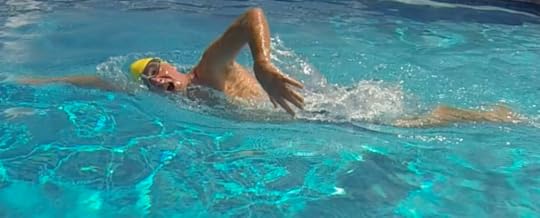
Breathe Efficiently
The second key to breathing with high frequency and high efficiency lies in how you roll to the side to take that breath. Poor breathing mechanics can increase drag and reduce the effectiveness of your stroke, during the breath. Here are several ways to remain efficient while breathing:
Roll your whole body to the air. Rather than breathing with a head turn—which is awkward and can cause muscle tension—think of rolling your body to the air, as if you were going to breathe with your belly button. This will also help encourage core-body rotation, which is the source of your stroking power.
Stay balanced as you roll to the air. Lifting your head as you breathe will cause your hips and legs to sink, increasing drag and slowing you down. Consciously keep the crown of your head and forehead pressed to the surface as you roll to breathe.
Stay aligned as you roll to the air. Picture a line that runs from your toes, along your spine and out the top of your head as a laser beam. Keep that laser cutting straight ahead through the water as you breathe—or think of slicing through the water like an arrow through the air, at all times but especially while breathing.
Stay tall as you roll to the air. Many swimmers lose the front end of their stroke on each breath. During each breath, focus on keeping the opposite hand stretched forward—with fingertips angled down to hold an “armful of water”—for just a moment longer during the breath. This timing will help connect that armstroke to the powerful rotation of your body in the other direction following the breath.
Drive the top hip down. After breathing, focus on driving that hip (i.e. the right hip after a right side breath and vice versa) down strongly. That will help you get all the power out of the extra rotation that occurs when you roll to breathe. If you do all of the above right, you can make each breath an asset to your stroke, not an interruption.
To learn more in-depth detail about the breathing mechanics of efficient swimming, check out our video “O2 in H2O: A Self Help Course on Breathing in Swimming”– available as a digital download or on dvd.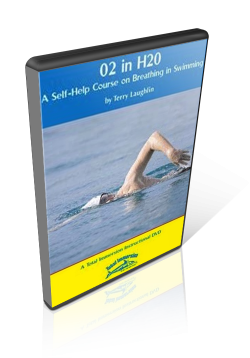 Nothing is more essential to a swimmer than air. Yet, few swimmers truly understand how to breathe efficiently…not just to get air, but to integrate breathing seamlessly with the stroke. Breathing is sometimes viewed as a liability or inconvenience, but when you do it right, breathing can actually make your stroke better. This video shows you how, using water bowl exercises, shallow water exercises, skills in drills, and whole stroke breathing skills. Detailed studies with focal points for practice cover these three major strokes: Freestyle, Breaststroke, and Butterfly.
Nothing is more essential to a swimmer than air. Yet, few swimmers truly understand how to breathe efficiently…not just to get air, but to integrate breathing seamlessly with the stroke. Breathing is sometimes viewed as a liability or inconvenience, but when you do it right, breathing can actually make your stroke better. This video shows you how, using water bowl exercises, shallow water exercises, skills in drills, and whole stroke breathing skills. Detailed studies with focal points for practice cover these three major strokes: Freestyle, Breaststroke, and Butterfly.
The post Freestyle Breathing 101: Master the Mechanics appeared first on Total Immersion.
July 19, 2019
BEACH ENTRY AND EXIT: Get Comfortable in the Ocean
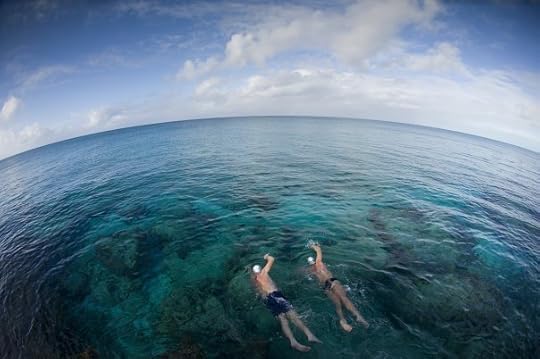
[Editorial Note: The following is excerpted from Chapter 21 of Terry Laughlin’s 2002 book, Triathlon Swimming Made Easy: The Total Immersion Way for Anyone to Master Triathlon or Open Water Swimming]
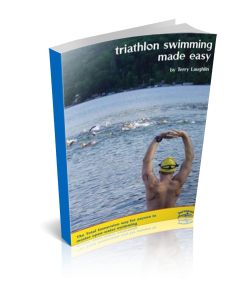
REALLY OPEN WATER
Ocean swimming is a whole different story. The best way to become comfortable and adept is to spend some time body surfing. It provides a perfect opportunity for mastering sea skills while having fun. Body surfing teaches you to be completely at ease in the ocean, and particularly, to understand waves. Swimming through breakers takes strength, wit, and timing. You can’t just mash through them; they’ll throw you back, gasping and muddled. Body surfing is ideal practice because after each ride in, you can’t wait to catch another, so you learn to zip through the shore break quickly, with energy intact to grab your next ride.
Here’s how to do it. Start in ankle-deep water and high-step through the shallows, leaping over low rollers. Ocean bottom is notoriously unpredictable (a hole here, a sandbar there), so watch your step. But you probably won’t run far anyway, unless the tide is way out; it’s easier to porpoise once the water covers your knees. Dive forward, grab the sand, and pull your feet under you. Plant your feet, then dive up, and over to arc back toward the bottom again. Each time you pop up, immediately look for the next wave. When depth makes this awkward or laborious, start swimming. But you have to check the wave line every two or three strokes.
If you see a shoulder forming that looks as if it could break, you’re probably over a sandbar. Try to get your feet down and prepare to dive under the wave. The ideal time, if you’re fortunate enough, is to dive through the base of the wave just before it breaks. That will actually shoot you out the back with added momentum. If you can’t manage that, just duck under before it reaches you.
Or, you may be facing 30 yards or more of rollers that broke farther out and are coming at you in lines, usually in water too deep to porpoise. Sometimes you may be able to take only a few strokes before another wave is on top of you, forcing you to dive again. Leave one arm in front as you breathe, swing the other arm over, and drive it in strongly as you pike under. Breaststroke once quickly and resurface, looking immediately for the next wave. Get in as many strokes as you can to power through the white water behind them, ready to dive under again. It can be difficult to get a rhythm going; you really need to be comfortable with being buffeted and thrown off your stride every few strokes, then resuming your rhythm quickly. As I said, there is absolutely no substitute for practicing this a lot.
(See video below for good demos of “porpoising” / “dolphin dives” and high-stepping)
Once you’re past the breaker line, you’ll be swimming in chop or swells of some height. Practice comes in handy here too, because it helps you learn to sense when you’re riding up on a crest or sinking in a trough. There’s no point in sighting while in a trough. With experience, you learn to time your looks for when you feel yourself rising on a swell. In July of 2000, I swam a mile race in storm surf where the swells ranged upward of five feet, which limited the size of the field and scattered it considerably. Most of the time I swam blindly in what I hoped was the right direction, pausing frequently to take 2-4 breast strokes, hoping to catch a glimpse of another swim cap. When I saw one, I’d swim that way, anxious for company out in the wet-and-wildness. In any sort of chop, which is common in the ocean, it helps enormously to have had considerable experience getting your bearings. You need to learn to time the waves, and to perhaps delay a breath (or breathe to the other side) because you can sense a wave about to slap you in the face. Another option worth practicing is to take a deep breath to your side, then look up and spot without swallowing water as a wave splashes over you.
I know it can sound scary but, in time, you essentially learn to roll with the punches, to trust your swimming ability and the safety measures of the race organizers, and to relax and find a rhythm in harmony with the swells around you. Three adjustments can be particularly helpful in a choppy sea: First, swing your arms a bit higher on recovery. Second, roll farther to breathe– just as far as you need to find air. Finally, be intently focused on piercing the waves, rather than bullying your way through them.
At some point, you’ll need to return to shore. If there’s a shore break of any size, it will definitely occur to you that you might get crushed by a wave sneaking up from behind. A swimmer who knows how to ride waves and how to “read” the ebb and flow of a breaker line can get to shore much faster and more smoothly. Once you’ve cleared the final buoy and are headed toward shore, don’t worry too much about finishing your swim right in front of the finish line. Instead of angling toward the finish line while swimming, swim straight in and and then run along the shore to the swim finish. You’ll get there much faster by running than by swimming diagonally and you’ll handle the shore break much better going straight in.
Once you are in the breaker zone again, you’ll feel this: A swell will catch up with you and you’ll feel your body accelerating. Swim faster, using the boost for as long as you can. Once the wave passes you, you’ll feel yourself being pulled back in the ebb. Work hard enough to counter this, then resume your normal rhythm again. Finally, you’ll be close enough to shore that you can sense waves beginning to break. Now is a good time to turn on your back for a few strokes to see if there’s one you can catch. When you feel yourself being sucked into a breaking wave, rotate to face down and swim three to four strokes at top speed, then put one or both arms forward, put your head down, and lean on your chest as you keep kicking.
Keep kicking and leaning on your leading arm for as long as you feel yourself in the wave. When it passes, if you can feel the bottom as you stroke, start porpoising. If the tide is out and there’s a long shallow zone between the break and the beach, throw yourself ahead of following waves as they catch up to you. It’s easier to catch a mini ride than to run and leap through knee-deep shore break.
(See video for a good demo of body surfing– you’ll need to kick vigorously, as noted, since you won’t have fins.)
How to practice this? Simple and fun. More body surfing. Most of the time you won’t be at the shoreline at the end of your ride, so you can practice porpoising, mini rides, and high-stepping out of the water. Another good form of practice at the beach is to set up a mini-course, repeatedly swimming out 50 yards or so, and then returning, always starting and finishing on shore. In the 1970’s, I worked as a lifeguard at Jones Beach State Park on Long Island. At Field 6, where I was stationed, we would set up a mini course by anchoring a milk or bleach jug about 75 yards from the main stand. On down time, we would often practice several dashes into the surf, stroking out to the buoy and then back to shore, finishing each by running to the stand. Whenever the surf was up, we’d spend hours body surfing. It was exhilarating fun– as well as invaluable practice of our rescue skills. I’ve loved racing in the ocean ever since.
Swim Safely
If you’re not fortunate, as I am, to have a group to practice with, don’t swim unprotected. Ask someone to swim with you or to paddle or row along. If your swimming partner is less experienced, keep an eye on him or her while you swim. If you swim where there’s motorboat or jet-ski traffic, you must have an escort boat, and you should always swim with a brightly colored cap. Otherwise, swim on a guarded beach. One of my practice sites, Lake Awosting, offers an enclosed-and-guarded area about 50 meters wide. If you swim in an unfamiliar spot, learn all you can about conditions: currents and riptides, submerged rocks, or pilings.
See last week’s blog post for open water tips on DRAFTING and PACING!
To read the full chapter on Open Water Practice and Racing, check out Chapter 21 of Triathlon Swimming Made Easy… or our “Outside the Box: A Program for Success in the Open Water” video! See clip below:
The post BEACH ENTRY AND EXIT: Get Comfortable in the Ocean appeared first on Total Immersion.
July 12, 2019
Open Water Tips: Drafting Practice and Pacing Games
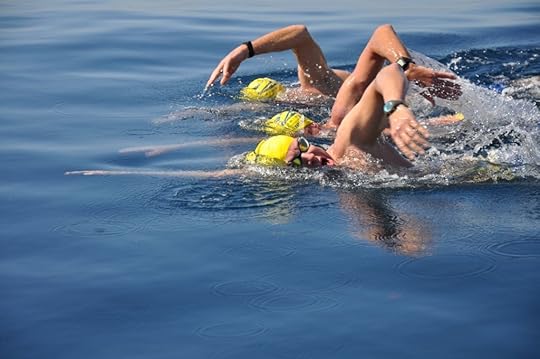
[Editorial Note: The following is excerpted from Chapter 21 of Terry Laughlin’s 2002 book, Triathon Swimming Made Easy: The Total Immersion Way for Anyone to Master Triathlon or Open Water Swimming]

Practice Free Rides
Swimming just behind someone else can be worth as much as 10% in energy savings. Just as helpful, you can let your draftees do the work of navigation while simply follow in their wake– but do check their bearings from time to time. I practice drafting in the pool, as I said, and at the lake, where I sometimes start at the back of the pack to practice drafting. I’ll do my no-look strokes and practice following other swimmers without actually looking for them. I try to sense their proximity by feeling the bubbles from their kick. You can also catch a ride by swimming alongside another swimmer (or between two swimmers) but close enough to stay within their bow wave, by keeping your goggles somewhere between their knees and feet. When drafting that way, can keep your “rabbit” in view with normal side-breathing.
After swimming “blind” for 40 or more strokes, I’ll sneak a quick peak at my draftee’s cap or for the center of the cluster of caps. Another way to use the pack to stay on course is by swimming to one side. If you know, for instance, that you typically wander to the left while swimming, position yourself to the right of most of the pack. Everyone else else will keep you in line.
Practice with Purpose
In addition to the gear-changing and timed pool sets outlined earlier in this book, in the lake I test and develop my ability to stay smooth at racing speeds with a variety of pacing games. I will generally swim in a range of three “gears.” Silent is virtually effortless. Cruise is a bit faster with some feeling of pace. Brisk represents the effort and pace I’d usually feel in the course of a mile race–but my race is complete after I swim, so this pace may be a bit faster than most triathletes would want to swim. Here’s a sample “lake workout” to show the range of creativity that is possible– each “set” represents one “lake lap” or just under 400 meters:
Swim Super-Slow and Silent. I try for the lowest possible stroke count and try to cross with fewer than four “looks” to sight.
Speedplay. Alternate rounds of 40 strokes Silent with 20 strokes Cruise. Try to be just as quiet and splash-free as you accelerate to “cruise pace.”
SSP (Sensory Skill Practice). Alternate thinking about your head position (relaxing the neck, hanging the head) and timing your switches, with purposeful exaggeration. Count strokes.
Speedplay. Alternate 50 Silent strokes–10 Cruise strokes, 40 Silent–20 Cruise, 30 Silent–40 Cruise, 10 Silent–50 Cruise. Be just as smooth for 50 strokes of Cruise as you are for 10.
Drafting Practice. Start at the rear and practice “feeling wakes” and not looking very often. Also practice how to advance within the pack by leapfrogging from the “free ride” of one wake to the free ride of another wake further ahead in the pack, like a trout working upstream from rock to rock.
Speedplay. Alternate 20 strokes Silent–20 strokes Cruise–20 strokes Brisk. Try to stay just as smooth and fluent at Brisk as at Silent. You can also practice adjusting your tempo in the core, by keeping your arms connected to your faster-moving torso as you cycle through this repeatedly.
Pickups. Start at the rear of the pack, give the leaders a bit of a head start, then build your tempo and pace steadily across the lake, from Silent through Cruise, Brisk, and finally to full speed in the final 50 meters or so. This lap is a microcosm of a whole race, distilled to 400 meters.
See last week’s blog post for open water practice and racing tips on SIGHTING AND BREATHING!
To read the full chapter on Open Water Practice and Racing, check out Chapter 21 of Triathlon Swimming Made Easy… or our “Outside the Box: A Program for Success in the Open Water” video! See clip below:
The post Open Water Tips: Drafting Practice and Pacing Games appeared first on Total Immersion.
July 4, 2019
4th of July Sale! — And Open Water Practice & Racing Tips!
(THIS WEEKEND ONLY. SUPPLIES ARE LIMITED. ONE CAP PER CUSTOMER)
OPEN WATER TIPS ON SIGHTING AND BREATHING
 [Editorial Note: The following is excerpted from Chapter 21 of Terry Laughlin’s 2002 book, Triathon Swimming Made Easy: The Total Immersion Way for Anyone to Master Triathlon or Open Water Swimming]
[Editorial Note: The following is excerpted from Chapter 21 of Terry Laughlin’s 2002 book, Triathon Swimming Made Easy: The Total Immersion Way for Anyone to Master Triathlon or Open Water Swimming]
Each summer, I divide my swimming between an outdoor 50-meter pool in New Paltz, and several lakes in the nearby Shawankgunk Mountains. At the pool, I swim at slack times, with no lane lines so I sometimes have to weave through other bathers, providing “open-water practice” of a sort. I further simulate open-water in the pool by doing the following:
Swimming “blind.” Swimming 50-meters without lanes lines tests how straight I swim when not following a line. As I take 30-40 strokes per length, I may swim 20-plus strokes with my eyes closed and see how far I’ve wandered from the line where I started. This will help me pick a frequency for sighting when I race.
Sighting. Once or twice each length, I can breathe and sight to the front, specifically practicing my ability to maintain balance and rhythm as I do. I can combine this with blind swimming– opening my eyes only when I lift my head– for an even more accurate simulation of the open water experience.
Drafting. I sometimes “draft” a few friends to swim with me and practice close-order drafting, swimming in tight single file down the pool, with the leader dropping to the end at each wall. [More detail in Ch. 21 of Triathlon Swimming Made Easy]
Porpoise. At the shallower end of the pool, I (or we) can begin the length with 3 or 4 porpoises before we begin stroking. We work on efficient, low-angle porpoising– channeling energy forward as we dive toward the bottom and back toward the surface, and on grabbing the bottom and pushing off quickly.
Look This Way
Without a line to follow, any swimmer will eventually travel in a circle; the best swimmers, in a 10-mile circle, others within the turning radius of a VW. In open water, you stay the course by occasionally sighting on landmarks, buoys, and swim caps. Practice can help you do that without losing your balance and flow. Here’s what I practice:
Look less often. When your technique improves, you’ll swim straighter. I often swim considerable distances without looking. It usually takes me about 320 strokes to cross the lake (yes, I count strokes even there), so I’ll often begin by taking 100 “blind” strokes without checking my bearings, to see how straight I swim. If I’ve gone considerably off, I’ll take fewer strokes before looking again. This gives me a sense of how often to sight in a race.
Sight smart. As we swim westward, our target is a dead tree angled into the water. Coming east, we swim toward a dock. Complicating the westward trip is sun glare that obscures the dead tree until we move into shadow, about 50 meters from the shore. How do I sight for the first 350 meters? On the bluff above the shore the treeline dips slightly just right of the spot we’re aiming for. So I sight on the dip in the treeline until we reach the shadows. Heading east, the dock isn’t clearly visible until the last 100 meters, so I use two buildings behind it, one a bit to its right and one a bit to its left, to “triangulate.” While warming up for a race, check for landmarks and other features that can help guide you when visibility is compromised.
Sight seamlessly. Sometimes the lake is almost as calm as pool water. When it is, I practice “surfing” my goggles barely over the surface, using my extending arm for support as I lift my head up and forward. Staying that low is far less tiring than holding my head aloft for several strokes in a row, but I may not get a completely clear picture. This sighting style is so easy to fit into a normal stroke rhythm that if I didn’t get a complete picture, I assemble one by taking a series of “snapshots” with brief peeks forward. And when windchop kicks up on the lake, I adjust by lifting just a bit higher or by taking more “snapshots.” These techniques help me maintain seamless balance and flow.
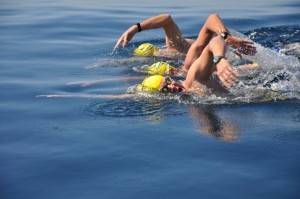
Breathe This Way
Breathing to both sides is a key skill for open water. Breathing to one side for 20 minutes or longer can leave neck and back muscles tense; breathing both ways keeps you looser. Second, you never know on which side your landmarks and buoys may be. And finally, waves, chop, or splashy swimmers on one side can be a problem unless you’re comfortable breathing the other way. Fortunately, our T.I lessons [earlier in this book] should have helped you become comfortable with bilateral breathing. I do most of my swimming in both pool and lake, breathing alternately. That could mean breathing every three strokes, or every five if I’m going super slow (my effort level is low and so is my oxygen consumption). It could mean breathing on the right side while heading west and on the left going east. It could mean 10 breaths on my right, followed by 10 on my left. I practice all kinds of alternating patterns, so I can shift easily while racing.
To read the full chapter on Open Water Practice and Racing, check out Chapter 21 of Triathlon Swimming Made Easy… or our “Outside the Box: A Program for Success in the Open Water” video! See clip below:
The post 4th of July Sale! — And Open Water Practice & Racing Tips! appeared first on Total Immersion.
June 28, 2019
“Five Gear Swimming”– Terry Laughlin’s 2004 Talk at ASCA World Clinic
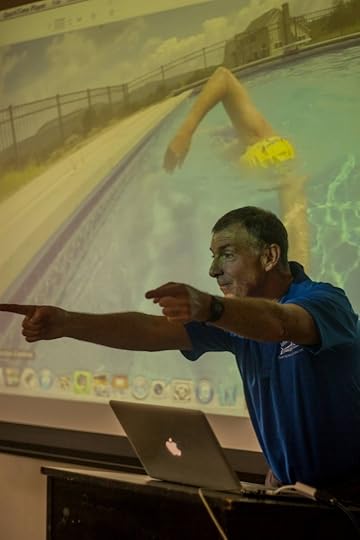
The following article is adapted from the transcript of a talk that Terry Laughlin gave at the 2004 American Swim Coaches Association (ASCA) World Clinic. For brevity, this lengthy talk has been edited for this blog, but readers can view the entirety of the transcript HERE, on ASCA’s page. Terry entitled the talk “Five Gear Swimming” and describes in-depth how one can develop “gears” in one’s stroke, by consciously cultivating a range of precise stroke counts over different speeds and different distances. Among observations in his full remarks, Terry said: “What I see distinguishing champions from all the other gifted and highly trained athletes at a World Championship is the ability to execute with greater choice and control. And this is something that I think any swimmer – even 10 year olds to some degree – can be taught. If we can identify the skills, habits and behaviors that are associated with winning important races, it’s my contention that we should spend as much of our training time as possible teaching and honing them….and we get in shape while we do it, rather than focus on getting in shape and hoping that race-winning skills somehow develop along the way.” This talk– and Terry’s practice sets at the bottom of this transcript– are focused entirely on demonstrating how we can hone and train those skills, particularly increasing stroke length and developing precise speed (similar to consciously shifting gears on a bike or a car). Enjoy and Happy Laps!
[Editors Note: There is a copy of Terry’s practice set handout at the end of this article.]
Over the years I’ve talked to a half dozen swimmers who set world records. I always ask them: “What did it feel like to swim faster than anyone in history; what sensations did you experience during the swim?” Every one of them described feeling great. None talked about having to “push through pain barriers.” I spent the first week of February in Austin with Eddie Reese. While there, I asked Aaron Peirsol, Brendan Hansen, Neil Walker, and Ian Crocker that question. Aaron described his world record swim in the 200 backstroke this way: “When I hit the touchpad I felt like I could have kept going at that speed.” All four said similar things.
I think that can help us understand how Michael Phelps is able to string together so many fast races in period of a few days, setting four or five world records in a few days at the World Championships, or racing 17 times in eight days at Athens. One critical reason is that his lactate reading is incredibly low after a fast swim – he’s been measured at 5.0 millimoles of lactate per liter of blood, compared to readings of 15 or higher in some swimmers. Some people think he just has freakish physiology. I’m more inclined to believe it’s because he swims with superhuman economy of movement. I think he swims so fast precisely because he doesn’t give a maximum effort – because he’s always under control. That makes me think we may put too much emphasis on pushing through pain barriers. I’d rather have my swimmers feel like Aaron or Michael in their races. To get them there, I teach them to feel good at slower speeds and to continue feeling good at progressively faster paces.
We do that through the kind of training described on these slides, which has the goals of: (a) increasing your SL, (b) expanding your capacity to go greater distances and achieve greater speeds within your SPL range and (c) learning how to be effective at your red line.
This slide illustrates how we describe training speeds for our swimmers. I suppose many of you are familiar with the list of training speeds prescribed by U.S. Swimming. The other day when I led the Stroke School, I had to ask coaches in the audience what they were. After 32 years of coaching I’m clueless as to how they’re labeled and what they mean. I’ve read the list but I can never remember all the labels, let alone the work-to-rest ratios and rest intervals for each. If I was to tell someone on my team, “I want you to swim this at EN3,” they’d just look at me blankly.
So we use a much simpler set of just five training speed descriptions that have proven perfectly adequate in my own training. I didn’t bother giving them labels until I began coaching the team, because I needed a simple way for them to understand what I was asking for in a set. I expect they will work better for my team of average swimmers than a more complicated system. Here are our training speeds:
Perfect – This is our slowest training speed — warmup or recovery pace or even below. It represents whatever speed you are able to do when swimming the most meticulously perfect stroke you can. Whenever we do any recovery swimming after intensive efforts we’ll do it at the highest possible efficiency levels.
Cruise – This is our next training speed. If I ask you to define “Cruise” for me what words would you use? That’s right: smooth and sustainable; in running terms, it might be called “conversational pace.” I can continue at this pace for a while without feeling any stress or perhaps breaking a sweat..
Brisk – At this level I’m adding a little speed. It’s like breaking a sweat while running, feeling that your heart rate is rising. My chest isn’t heaving, but I have the feeling of doing a bit of work, but still submaximal. Another term for it might be “easy speed.”
Race – This pace is race specific. If I say “Race speed” and we’re talking about the 100 Breaststroke, that’s one feeling; if we’re talking about a 200 Breaststroke that’s another feeling. “Race” will mean something different when thinking about the middle of a 1500-meter free than when thinking about the middle of a 400 meter free. The most important aspect of this training speed is that I want my swimmers in training to be able to vividly relate nearly any set to a specific sense of effort/tempo/power they would feel when swimming their best at a particular stage of a particular race.
Race Plus – This speed is anything above that. And once again it’s race specific. A training set that feels like “Race” speed for the 400 meter swim could be “Race Plus” for the 1500 meter swim. If the swimmer is training to race the 1500 meters at 38 SPL (per 50 meters) and expects to race much of the 400 at 40 SPL, then the stroke count being maintained in the set could determine whether the swim was Race or Race Plus. A set of 35-second 50s at 40 spl could be Race for the 400 meters. A set of 35-second 50s at 38 spl would be Race Plus for the same swimmer’s 1500.
What I like about this structure is that it employs language any swimmer can understand immediately and it’s highly practical. If I say Cruise to my swimmers, they know instantly what I’m talking about. Further, after training for 30-plus years myself, I’m pretty tuned into effort levels, but I simply cannot make distinctions between 9 levels of effort so I can’t help but wonder what practical purpose that serves. Five training speed categories seem quite adequate to me.
Another way to do what I’m describing here is to use tempo trainers – the beeping device you can wear on your goggles or in your cap. But if I have 30 swimmers and each trainer cost 25 bucks and we all have to fiddle with setting them before each set, that’s not practical in a team setting. Whereas if they each know their stroke count ranges from months of counting on various sets, we can easily use those counts to customize training for each individual.
I want my swimmers to own the controlling mechanism for their race. You can’t wear a tempo trainer in a race, but by counting strokes constantly and learning to adjust them at will, they can make decisions such as Brendan did in his 200 meter breast, in their own races. The steps to achieving this level of control are outlined on the handout:
Step One: Learn your Strokes Per Length (SPL). You do it by making stroke-counting a habit. We count all strokes, all distances. You’ll have the largest range of counts – four to six — in freestyle. In backstroke the range might be reduced by a stroke or two, depending on where you surface. Butterfly and breaststroke the range gets smaller yet, because a cycle of fly or breast equals two strokes of free or back. In breaststroke we work with a range of 3 or 4 stroke counts. Butterfly has the smallest range of counts to work with, because fly is pretty much all or nothing in rhythm. Reduce the rhythm too much and the stroke stalls. We have a range of 2 and in rare cases 3 strokes to work with. Again, if your pushoff is taking you 15 meters down the pool, that will reduce your range. For warmup we regularly do 100 IM’s with a range of 40 to 46 strokes. I also figure out appropriate stroke count ranges for every stroke combo (fly-back, or back-breast, or breast-free) we could do.
We start many of our practices with about 30 minutes of sets with Fistgloves. We count strokes with the gloves on and take note of how it changes when we remove them. Sometimes we swim at lower counts after removing the gloves and other times I’ll instruct them to take the same number of strokes without gloves that they took with them, to emphasize speed and tempo more.
We count cycles on many of our drills as well. We count the number of cycles it takes to complete 25 yards underwater dolphin. We do breaststroke pulls with no kick and goggles held above the water and count how many pulls it takes to go 25 yards. We always count our breaststroke kicks-per-length and virtually always count our dolphin kicks per length in streamline on the back or side. The count is a concrete measure of how effective your propulsive movements are.
I have no problem with people swimming slower when they are focused on improving their current SPL levels. Slower swimming with a purpose of examining and improving your efficiency – to strengthen your foundation when you resume speed later – is valuable. Swimming slowly, but with a very low count is an example of practicing discipline and concentration; the intent is always to add speed back in later but you should “drive a hard bargain” in trading strokes for speed as you do.
Step Two: Develop your range. Here are two simple examples. If I instruct a swimmer to go 25 yards at 13 strokes, then 50 at 26 strokes, then 75 yards at 39, and finally 100 yards at 52 strokes, as the distance increases, she’ll have to be more focused and disciplined to maintain the same SPL she might have done with ease for 25 yards. Going in the other direction, if I give a set of 200 + 150 + 100 +50, all done at 14 SPL, the swimmer will be able to add speed as the distances decrease, without trying simply because it gets easier to hold 14 SPL at progressively shorter distances. They may have to be careful and attentive to hold 14 SPL for an entire 200, but can move more freely as the distance gets shorter. By the time they get to the 50, they can swim somewhat aggressively, which naturally leads to swimming faster.
What’s the desirable training effect in that set? As they gain speed on the 150, 100 and 50 from their initial pace in the 200 – and maintain the same stroke count – in effect they are creating more V by raising their SR, while keeping SL the same. I didn’t tell them to raise their SR – it just happened as they swam faster. This gave them an experience of maintaining SL while raising SR, simply by reducing the repeat distance. That experience goes into their nervous system and becomes an aspect of skill that is usually only displayed by gifted swimmers. This way, we’re teaching “average” swimmers to master a very advanced skill. We may not talk about this explicitly but through practice this skill becomes implicit in the “neural software” they use to control their swimming.
If we do a “Pyramid” set – increasing distance on the first half of the set, then decreasing distance on the second half at a constant SPL – they practice being careful and disciplined going up, then adding speed as they come down. This way they solve two different puzzles on the same set.
For a distance set, let’s say we have a swimmer who has mastered the challenge of maintaining 13 SPL for a set of 10 x 100, and I want to test their ability to maintain 13 SPL for a full 1000, without taking a break every 100. I’ll emphasize to them that the challenge is to maintain 13 SPL for as long as they can do so comfortably, without straining to do so. Concentrating intently is good; putting a hitch or delay in your stroke – or gliding into the turn – is not good, because that’s bad practice. When they can’t maintain 13 SPL with rhythm and flow, I instruct them swim a length of “recovery backstroke” then resume freestyle at 13 SPL. The effect of this “active recovery” is to let them feel a bit more refreshed on freestyle.
The first time I give this, they might need to include 5 lengths of recovery backstroke in the 1000. The next time we do it, the goal would be to complete it a bit faster – or to need only 4 or fewer active rest backstroke laps. Working at it this way we can systematically expand their “efficiency range” while practicing only good form and rhythm. And as they subtract “recovery laps” from their total, they’ll also naturally improve their total time for the 1000. When they finally complete a nonstop 1000 at 13 SPL, they’ve programmed themselves to swim 1000 with consistent efficiency, rather than the more typical process of losing efficiency progressively as a swimmer pushes on to complete a long swim.
This doesn’t mean that I want them to swim a 1000 at 13 SPL all the time. But when they master it, if I tell them to swim a 1000 but allow them 14 SPL, they’ll be able to swim that 1000 at higher speed and still be at a great level of efficiency. And if I give them the OK to swim the second 500 at 15 SPL, then they can pick up speed. That gives us an implicit and natural way to practice and master negative splitting.
Step Three: Introduce “Gears” Practice. When they’ve mastered the art of swimming at a good level of efficiency, and applying that SPL over different distances and speeds, we can introduce what I call Gears practice, which I describe as “playing stroke counts like scales on a piano.” Before they ever attempt even a simple piece of music, piano students spend many hours moving their fingers up and down the keyboard and developing a facility for finding the right notes with ease. We want our swimmers to develop similar facility with their stroke counts or SL. A very basic set of this sort would be 4 rounds of 4 x 25, where on the first round they go 12-13-14-15. On the second round, they reverse that, then repeat those patterns on the next two rounds. As I said, I try everything myself before giving it to my swimmers. If you try this, you’ll discover that it’s a totally different puzzle to go from 15 to 12 strokes than it is to go from 12 to 15.
What I’m constantly looking for in practice design is to change the task with frequency, balancing the difficulty of the puzzle with their ability to solve it successfully. I make these puzzles progressively more challenging with time because I want their nervous systems to always be dealing with tasks that require concentration to succeed at. The swimmers love coming to practice when every set is a problem-solving exercise, rather than a rote repetition that’s little changed from day to day.
We don’t use the pace clock very often for these sets. Instead we’ll set the interval at a certain number of what I call “yoga breaths”, usually three to five. Or we’ll say that the first swimmer in the lane will leave when the third or fourth swimmer finishes. I want them to be totally focused on calibrating their SL, not on watching the pace clock.
Another important part of practice design is that virtually all of our sets include a basic group of tasks, which are repeated several times. We usually do three to four rounds of the basic set. The reason for repeating it three or four times is that usually spend the first round figuring out the puzzle. Their choices and adjustments improve in the second and third round and they consolidate the optimal solution in the fourth round. I explain that the first round or two their only goal is to get better at calibrating so if, on a particular lap you’re supposed to take 14 strokes, you reach the other end and strike the wall with your 14thstroke, no stretching or rushing necessary in the last couple of strokes. As you gain confidence in your calibration, you can swim more aggressively and add a bit of speed. This feels like effortless speed, because it comes out of an adjustment in timing rather than an increase in effort.
The series on this slide represents several different puzzles on rounds of 4 x 25, then 3 x 50, then 2 x 75 and finishing with 1 x 100. On the first round, they’re all at 12 SPL, requiring the discipline to maintain the same SL over increasing distances. On the second round, it’s still 12 SPL on the 25s, but we add one SPL at each increasing distance—13 SPL on the 50s, 14 SPL on the 75s and finally 15 SPL on the 100, allowing them to maintain or perhaps increase speed as the distance increases, but still be at a good level of efficiency at the end. The final round is the most difficult task of all – we allow 15 SPL on the 25s, reduce to 14 SPL on the 50s, to 13 SPL on the 75s and finally just 12 SPL for the 100. Subtracting strokes is always more difficult than adding, but subtracting as you increase distance is about as challenging a task as you can come up with. You’ve got to be relentlessly tuned in and meticulous on that 100.
What all those sets have in common, because of the constantly changing repeat distances and stroke counts, is the need to have every single brain cell turned on from beginning to end. I think the most valuable items are those that require intense concentration and meticulous execution. If I can keep their brain cells fired up for an hour or two, we’ll have a high-value practice. I think it’s far more important to turn on brain cells than muscle cells. Muscle cells will get recruited regardless – you can’t go down the pool without using your muscles and aerobic system — but if I consider brain cells first when planning practice, I’ll end up with swimmers who are fit and better prepared to take initiative and be resourceful.
Time or speed are secondary when I introduce these Gears sets; we usually don’t even use the pace clock on them. My initial goal is for them to master the art of making subtle changes in stroke length and gain the control to swim at any count in their SPL range at will and with consistent accuracy. When I see they can choose and achieve their counts consistently, and seamlessly change counts up or down then we’ll start referencing the pace clock.
Another reason we don’t use the pace clock initially is to foster the “clock in the head” feeling. I want them to “know in their bones” whether they’ve gone faster and to develop a more finely calibrated sense of relative speeds. First gain the coordination to change stroke counts seamlessly, then learn how to swim faster without changing your counts, then learn how to swim faster BY changing your count – speed as a product of higher level coordination, rather than more intense effort. And finally we can use the pace clock to let them associate a concrete value, in minutes and seconds, with the kinesthetic sensations they’ve already developed.
Too often the pace clock becomes an unforgiving taskmaster, in every set, from beginning to end of season, from start to finish of practice. By turning off the clock when I introduce these sets, we focus on the skills and coordination that produce speed, then quantify those speeds later. I think this is the key to developing high-level racing and pacing skills. You can’t refer to the clock in the middle of the race; all you have to go on is your own sense of speed. I believe that sense is more highly developed if they train without the clock at times but are given “speedplay” exercises.
Step Four: Introduce the Pace Clock By introducing the pace clock as one measure of how you’re swimming, but not the only measure, and introducing it when your swimmers have mastered foundation skills, I think you can use it more effectively. Swimming Golf is one of the simplest ways to do that. The simple way is to add your Strokes plus Seconds for a given distance to arrive at your score. 25 strokes plus 30 seconds equals a Score of 50. Adding one more measure to that score increases its value enormously. That would be your Rate of Perceived Exertion (RPE) or perhaps Heart Rate (HR). Scoring 50 with an RPE of 2 (on a scale of 5) or HR of 130, would be better than the same score with an RPE of 4 or HR of 180.
We do Swim Golf in many ways. If you do four 50s, all at 35 seconds, but figure out how to subtract one stroke each time that’s a valuable exercise. Or four 50s at 25 strokes, but figure out how to descend 35, 34, 33, 32 seconds without changing the stroke count is a completely different puzzle, equally valuable. Or I might ask them to swim four 50s, all at a total score of 60. First 50 is 32 strokes and 28 seconds, next at 31 strokes and 29 seconds, third at 30 strokes and 30 seconds and the last at 29 strokes and 31 seconds. As you go through the set, you’re asking yourself which combo, at a score of 60, gives me the lowest RPE. What’s the easiest way for me to achieve a score of 60? An exercise like this helps them develop a feeling for swimming some stage of some race more economically and effectively; at some point they’ll probably use this intelligence to stay in good position, while remaining well under their red line…and that becomes a skill that may produce a winning finish.
I explain to my swimmers that the feeling and SL/SR combination that produces your lowest Golf score will not equate to your top speed. As you approach your highest speeds, you can’t really trade one stroke for one second, without overkicking or something else that increases your energy cost. But a great Golf score does equate well to how you’d like to feel in the first quarter of a race, when you’re trying to put yourself in good position, with the lowest heart rate or stroke rate of anyone in the field, setting yourself up to control the pace in the second half.
In another exercise we’ll descend several brief rounds – perhaps 3 x 50s in each round – at each of several stroke counts, perhaps a round each at 26 strokes, 27 strokes, 28 strokes and 29 strokes. I would probably put a recovery 50 – at 23 strokes — between rounds. Our goal is to aim for your best possible score at each count. I’ll ask the swimmers to find out which stroke count produces the lowest score at the lowest RPE; the answer will not be the same for every swimmer.
What I like most about this set is that it gets them to execute a slightly different set of neuromuscular instructions on every single 50. As they swim slightly faster on each of the first 3 x 50s, at 26 strokes, they will have swum a slightly different V/SR combination at the same SL on each 50. They’ll repeat that at a new SL in each successive round. In the course of those 12 x 50s, they will swim 12 slightly different, but completely unique, combinations of SL and SR. If you value nervous system stimulus as part of your training, what could be more valuable as a way of discovering their own most optimal combination of SL and SR?
That systematic experimentation is utterly different from what happens most of the time in conventional training. We give our swimmers countless sets of 500s, 200s or 100s in the course of a season…and they swim them all pretty much the same. But the primary requirement to create continual training adaptation is to find stimuli for our various physiological systems; it seems to me we’re missing out on a great opportunity to maximize training effect, by not assigning sets to be done at different stroke counts.
A different approach to the same idea is by using time, rather than stroke count as the regulator. Swim 3 x 50s at 33 seconds, at different stroke counts, then 3 x 50s at 32 seconds at the same range of stroke counts, then rounds at 31 and 30 seconds. At the end, again ask which combination produced the lowest Golf score with the lowest RPE or HR. Once again, in each of 12 x 50s in a set, they’ve processed slightly different information in their nervous system.
The more frequently you can get the nervous system to master a new task, the more adept and automatically it can find the optimal solution – the one with the lowest energy cost. And greater frequency in processing new information in the nervous system is also the factor most associated with moving the related skill up to autonomic brain centers from the centers of conscious control. Making skills “automatic” is critical to racing success, particularly in shorter events.
This is my personal bias, but I think that it’s far more important to train the nervous system — to be adaptable, to make smart choices, to make subtle adjustments well, etc. — than to train the aerobic system. Again, I emphasize, the aerobic system always gets trained, no matter what you do. But the nervous system only gets quality training when you make that a priority in your practice planning.
Here’s a stroke-changing Swim Golf set we did last week. We did four rounds of 5 x 50. In each round, the first 50 was backstroke, the second 25 back + 25 breast, the third breaststroke, the fourth 25 breast + 25 free and the fifth freestyle. We did the first two rounds with fistgloves, then removed the gloves for the last two rounds. In each round we did the first four 50s at Perfect speed (from the training speeds mentioned earlier) and the fifth 50 try to get your best Golf score, using any combination of strokes plus seconds. Other ways of doing this could be to score the odd 50s and swim Perfect on the evens, or Perfect on the odds and try for best score on the evens depending whether you wanted to work more on the stroke or on the stroke combo, which would emphasize the IM training elements.
The range of possible sets like these is limited only by your imagination. Apart from the health benefits, one of the great paybacks I get from my own swim training is that it stimulates my practice creativity. I always come out of the pool with several great training ideas. I don’t get nearly as many ideas sitting at my desk, as I do while swimming and immediately after.
Here are sets I use that are typical of those I do to train for distance . None of the Hawks are quite ready for this kind of distance training yet, but when they are – probably after a few months of seasoning — I’ll give them similar sets. The first example is a set of 5 x 500. On the first I limit myself to 13 SPL. I find it a tremendous challenge to complete a 500 in that count, which forces me to be super-attentive to every stroke. If I miss a turn just slightly, or am a bit sloppy on my pushoff, I know it will be that much harder to make it to my next turn in 13 strokes. One poor turn can create a spiral of difficulty, because a loss of momentum going into the next wall – because you had difficulty getting there in 13 strokes – means the next turn and the lap that follows will also be harder. So if I want to sustain 13 SPL for a full 500, I can’t slacken my attention for a moment.
On the next 500 I only have to hold 13 SPL on the first 250, then go to 14 SPL on the second 250. And just because of the extra stroke each length, I’ll usually negative split. I don’t even have to try to negative split. Simply because I have the freedom to take 14 strokes on the second 250, a negative split happens. On the third 500, I’ll allow myself 14 SPL – I’m going to swim this one a bit faster than the previous one, simply by taking more strokes. On the fourth 500, the same thing happens as on number two – a negative split – but this time it’s faster because the stroke count is 250 at 14 SPL and 250 at 15 SPL. And the last 500, I’ll take 15 SPL all the way, which will make this the fastest 500. I might even let myself take 16 strokes on the last 100 – but if I do, that will be a choice not an accident.
Another way I’ve swum 5 x 500 that also creates a natural descending and negative-splitting set, but with a narrower stroke count range is to swim the first 500 at 14 SPL, on the second 500 hold 14 SPL for 400, then go to 15 SPL on the last 100. Each succeeding 500, I’ll shift one additional 100 to 15 SPL, working from back to front. The last 500 will be 100 at 14 SPL plus 400 at 15 SPL. That first 100 at 14 SPL will make me stay controlled at the beginning, setting me up to finish strongly as the stroke count goes up.
Swimming 500-yard repeats this way imprints the habits that program you to swim the 500 with the progressive pacing that has been the usual pattern in NCAA and American records, which is what I mean when I talk about training as rehearsal for the skills that win races.
The Masters coach were I swim gives us three to five 500 repeats every Tuesday evening. In the course of a year’s worth of training we probably swim at least 150 practice 500s. I’ll bet many club swimmers do as many as 200 to 250 500-yard repeats in the course of a year. When you swim this many practice 500s in a season, how do you avoid mindless repetition? My goal is to find a way to make every 500 we do in the course of a year a meaningfultraining exercise. Stroke count and pace challenges are one of the ways I do that.
Here’s a set I’ve done that would be appropriate for middle distance swimmers – 5 rounds of 4 x 100. You do the first round at 48 strokes (12 SPL), descending from 1 to 4. For me, descending a set of 100s at 48 total strokes, is tough; on the fourth 100 in that first set my brain is working overtime searching for some way to add a bit more speed, without going to 49 strokes. On the second round, I’ll get to take 52 strokes (13 SPL) as I descend the next four 100s. After doing the first set at 48 strokes, the second round at 52 strokes is still a fairly low count, but it seems like a lot of strokes. I descend again, aiming for a faster average than on the first set, not difficult at all with the extra stroke each lap. On the third round I go to 56 strokes (14 SPL) and I have to concentrate a bit on staying smooth, because 56 feels like a high SR. On the fourth round I get 60 strokes and I’m focused on fitting in what feels like a lot of strokes, but staying smooth and controlled as I do. And then I do a 5th round where I do 1 x 100 at each count – or I could swim each 100 at 12+13+14+15 SPL, where I’m pushing my nervous system to change SL and SR more quickly.
Another set is four rounds of 4 x 50 on a minute, ascend-descend. If you hold all 16 50s at 27 strokes, and descend the first four, that’s easy. But ascending the next four, still at 27 strokes, is a tougher brain puzzler because few swimmers ever do that in training.
Here are some sets for sprinters. The first one I pulled from my West Point log book is 16 x 25. You do the first four with Fistgloves – though you could do the set without gloves if you want. On the first round, you just swim Brisk and count your strokes. Take the average count from that set and it becomes your “N” for the rest of the set. Let’s say you average 13 SPL. The rest of the set is 4 rounds of 3 x 25. In each round, the first 25 should be at N-2 or 11 strokes, the second 25 at N-1 or 12 strokes, and the third 25 at N or 13. You swim the N-2 at 95% speed — very nearly as fast as you can go, but at two fewer strokes. Another puzzle to solve: I only get 11 strokes but I have to swim it fast – how do I do that? And each 25 is a different task than the one before and after it – so the brain has to process an updated instruction set on each of the twelve 25s.
Another sprint set: 4 rounds of 4 x 25s. All the odd 25s are Silent. I think of Silent Swimming as a “crystallizing focal point.” When they swim silently, however they choose to solve the problem of eliminating noise in the stroke, they always swim more fluently and efficiently. Rather than focus on head position or where the hand enters, etc, this is an all-encompassing focal point. In order to swim silently, everything has to get better, and it does. So the odd 25s are all at 12 SPL, Perfect speed and Silent. And the even 25s are one each at 12, 13, 14, 15; we repeat that pattern on the last eight. Each of those are to be swum as fast – and as quiet – as possible. When we do descending sets or fast sets, I always tell them to listen to themselves as they do and to make the least noise they possibly can when going fast. Try it; your swimmers will swim more efficiently when you just give them that instruction.
Here are some examples of sets using different strokes. You can create more intensive neuromuscular stimulus in backstroke by varying both the number of dolphins and the number of strokes. This is two rounds of 4 x 50 backstroke, all at 11 SPL. In each round they do the first 50 with three dolphins off each wall, then 11 strokes, the second 50 with four dolphins then 11 strokes, the third with five dolphins plus 11 strokes and the fourth with six dolphins plus 11 strokes. As they increase from three to six dolphins, they have to “fit in” their 11 strokes faster. On this set, they are not only practicing a rate change on their swimming, they’re also getting to work out the optimal number of dolphins.
People don’t always use the same number of dolphins on the pushoff. From beginning to end of a 200 many swimmers will usually decrease the number of dolphins they take before surfacing. If my swimmers will make an adjustment like that I’d rather it be planned and practiced, not an accident. So we practice backstroke with varying numbers of dolphins. Sometimes we keep the number of strokes consistent, though the dolphins change. Other times we’ll change the stroke count or let if float, as the number of dolphins changes.
This breaststroke set is one I gave Brendan Hansen when Eddie Reese invited me to plan a couple of sets for the UT swimmers. In a set of 8 x 50, the first was at 4+4 strokes, the second at 4+5, the third at 5+5 the fourth at 5+6, the fifth at 6+6, the sixth at 6+7, the seventh at 7+7 and the final 50 at 7+8 strokes. Brendan felt comfortable on the first six 50s, but had trouble fitting in 7 strokes and couldn’t complete eight strokes on the final 25. He “ran out of pool” in other words. I suggested that he take it as a challenge to fit in 8 strokes…and do it smoothly, without feeling ragged or choppy. On his own, he did the set a second time and solved that puzzle. What I enjoyed was how he got out of the pool enthused over how much fun he had solving that SL puzzle. Even with his level of accomplishment and experience, he was susceptible to an approach that made the set interesting and fun by adjusting the stroke count on each successive 50 and challenged him with a task that he had to concentrate to succeed at. Could “functional fun” like that be anything but a good thing?
Five-Gear Swimming Handout
Step 1: Learn your SL
Make counting a habit.
All Strokes – All Distances
IM’s and Combo’s too
During/After Technique Practice & Fistgloves
Certain Drills & Underwater Dolphins
“Stroke Discipline” matters more than speed.
Step 2: Expand your SL Range
Ladder Up: 25+50+75+100
Ladder Down: 200+150+100+50
Up-Down 25+50+75+100+75+50+25
Distance Test: 1×500 – 1×1000, etc.
Step 3: Learn to “Play” SL (like piano scales)
4 x 4 x 25: 12-13-14-15-15-14-13-12…
3-4 rounds of 25+50+75+100
25@12/50@12+13/75@12+13+14/100@12+13+14+15
4×25+3×50+2×75+1×100
@ 12-24-36-48 total strokes
@12-26-42-60 total strokes
@15-28-39-48 total strokes
First learn to calibrate
Then add “easy speed.”
Step 4: Focus on Time/Speed
Swim Golf (strokes + seconds = score)
4 x 50 @ :35 Descend from 30 to 27 strokes (65 to 62 score)
4 x 50 @ 30 strokes Descend from :35 to :32 (65 to 62 score)
4 x 50 @ 60 SCORE – How many different stroke counts?
32+:28/29+:31/30+:30/29+:31/28+:32
Which combo best HR/RPE?
Best Scores @ Different Stroke Counts
3 x 50 @ 26 strokes
3 x 50 @ 27 strokes
3 x 50 @ 28 strokes
3 x 50 @ 29 strokes
Descend score on each round and compare.
Which count produced best combo of score/HR/RPE?
Best Scores @ Different Speeds
3 rounds of
1 x 50 @ :34
1 x 50 @ :32
1 x 50 @ :30
1 x 50 @ :28
Try for best score @ each speed.
Stroke Combo Sets
4 rounds of: (1-2 w/FGs)
1 x 50 BK
1 x 50 BK-BR
1 x 50 BR
1 x 50 BR-FR
1 x 50 FR
Score odd 50s, Perfect/count on evens
Perfect/count on odds; Score on evens
Perfect/count on 1-4; Score on #5
Specific Race Prep
Distance
5 x 500
#1 @ 13spl
#2 @ 13-14spl
#3 @ 14spl
#4 @ 14-15spl
#5 @ 15spl
5 x 500
#1 @ 14spl
Middle Distance
5 rounds of 4 x 100. Descend each 1-4
1st round @ 48 strokes
2nd round @ 52 strokes
3rd round @ 56 strokes
4th round @ 60 strokes
5th round @ 48-52-56-60 strokes
4 rounds of 4 x 50 on 1:00
Descend/Ascend x 4s
Hold all 50s at 27 strokes.
I.E. :36-:35-:34-:33-:33-:34-:35-:36 x 2
Sprint
16 x 25 w/FG
1-4 Swim “brisk” & count strokes. Average becomes “N”
5-16 in 4 rounds of 3. In each round, #1 @ -2 SPL, #2 @ -1 SPL, #3 @ N
Swim each SPL at 95% speed.
4 rounds of 4 x 25
All odd 25s @ 12 SPL – Silent & Perfect
Even 25s @ 12-13-14-15-12-13-14-15 SPL
All as FAST & as quiet as possible.
Different Strokes
Swim 2 rounds of 4 x 50 BK – All @ 11 SPL
Descend each round
#1 w/3 Dolphins
#2 w/4 Dolphins
#3 w/5 Dolphins
#4 w/6 Dolphins
Swim 8 x 50 BR. Descend 1-8
#1 @ 4SPL
#2 @ 4+5SPL
#3 @ 5SPL
#4 @ 5+6SPL
#5 @ 6SPL
#6 @ 6+7SPL
#7 @ 7SPL
#8 @ 7+8SPL
Read the FULL article at: https://swimmingcoach.org/five-gear-swimming-by-terry-laughlin-2004/
The post “Five Gear Swimming”– Terry Laughlin’s 2004 Talk at ASCA World Clinic appeared first on Total Immersion.
May 10, 2019
Kaizen Training: Cultivate Smart Speed with “Swimming Golf” Sets
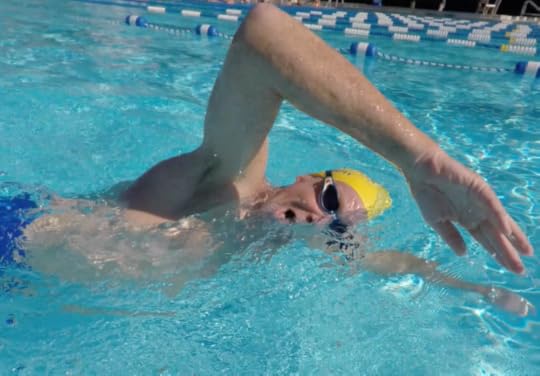
This week’s post is the final installment in a series of articles we’ve shared this past month on Kaizen Training, all of which have been excerpted from a companion instructional manual that Terry Laughlin created for T.I. workshop attendees, adapted from his 2006 book, “Extraordinary Swimming for Every Body.” Terry’s practical guidance in this manual focuses on how T.I. swimmers can strategically develop a Kaizen (Continuous Improvement) Training approach to their swimming practice in the first several weeks or months– and beyond– following a T.I. workshop (or after learning with T.I. self-teaching tools). In this article, we pick up where we left off in last week’s post on “Effective Swimming,” which described how to develop efficient speed through the practice of stroke counting. Now, we add the element of time to our practice– in these sample “Swimming Golf” practice sets– to demonstrate how to effectively use the pace clock with our stroke counting to advance your development of smart speed. Enjoy… and Happy Laps!
SELECTED EXCERPT FROM:
“KAIZEN SWIMMING: HOW TO MAKE THE MOST OF YOUR TOTAL IMMERSION WORKSHOP”
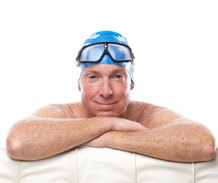
PHASE III: EFFECTIVE SWIMMING– SWIM FOR TIME
Up to now, we’ve ignored the pace clock– something verging on heresy among swimmers and coaches. But we’ve had good reason: Allowing you to fully develop swimming as an art has readied you to train for it as a sport, with far greater return for your investment of precious time and energy. With stroke count now ingrained as your most important piece of training data, you can then begin using the pace clock to give you another piece of information to cross-reference with your stroke-count numbers. This will give you the complete swimming-improvement picture. This includes “Swimming Golf” and many creative ways of doing time-oriented sets. Here are several examples to get you started:
SWIMMING GOLF
We introduce the pace clock, but use SPL and perceived effort (heart rate) to measure the “cost” of any speed increases. The easiest way to increase speed isn’t more or harder work; it’s by learning to swim any given speed more economically, freeing the energy to go farther or faster.
Version 1: On successive 50s, swim the same time but reduce your stroke count.
Example:
32 total strokes + 50 seconds = a score of 82
31 total strokes + :50 = 81
30 total strokes + :50 = 80
The goal is to repeat the same time on each 50, but to continue subtracting strokes, until you can’t shave any more from your count without sacrificing speed. Solving it will give you valuable “swimming intelligence.”
Version 2: On successive 50s, maintain stroke count, but descend your time.
Example:
30 total strokes + :45 = 75
30 total strokes + :44 = 74
30 total strokes + :43 = 73
To improve your score you need to keep exactly the same stroke length, but take each stroke just a bit faster to shave seconds. You’ll be amazed at how quickly a bit more effort can add a lot more strokes. If those strokes don’t translate into enough speed to lower your total score, you know you’ve been wasteful and can take immediate steps to fix the problem.
VARIATIONS ON SWIM GOLF
[Editorial Note: If you do not own Fistgloves, swim with closed fists. To learn more about this tool, click HERE.]
“Play” golf with fistgloves. How close can you come to our ungloved score? After several rounds with gloves on, do another round without them. Does your score improve over previous ungloved sets after “educating” your hands? If so, lock in the sensations you got.
How many ways can you score? After you’ve established your “par,” test how many different stroke counts you can swim at a slightly higher score. If your record score is 77, can you swim a constant score of 80 at 30 and 31 and 32 and 33 and 34 strokes? Which feels easiest?
Take your Heart Rate or estimate your Perceived Exertion after a good score. A score of 64 with a HR of 120 is much better than a 64 with a HR of 150.
There you have it– the final practice tool to start on the path toward Kaizen Swimming. Happy Laps!
Advance beyond the basic T.I. skills with this comprehensive guide on pursuing the kaizen path of swimming to the highest levels of swimming mastery:
Terry Laughlin’s book– Extraordinary Swimming for Every Body– shows you how!
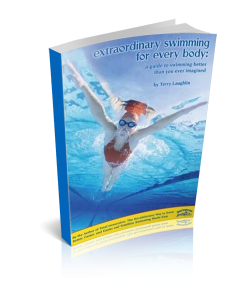
The post Kaizen Training: Cultivate Smart Speed with “Swimming Golf” Sets appeared first on Total Immersion.
May 3, 2019
Kaizen Training: Stroke Counting Tips & Practice Sets to Increase Mastery, Distance, and Speed
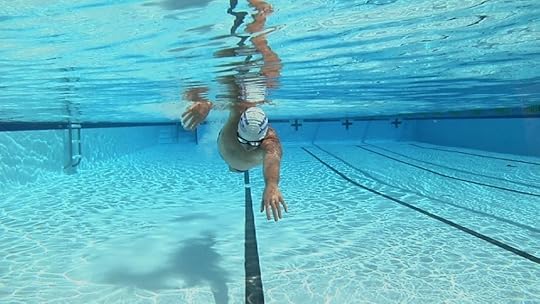
Continuing with the series of articles we’ve shared in the last several weeks, this post– “Phase III: Effective Swimming”– is another excerpt from a companion instructional manual that Terry Laughlin created for T.I. workshop attendees, adapted from his 2006 book, “Extraordinary Swimming for Every Body.” Terry’s practical guidance in this manual focuses on how T.I. swimmers can strategically develop a Kaizen Training approach to their swimming practice in the first several weeks or months– and beyond– following a T.I. workshop (or after learning with T.I. self-teaching tools). In this article, Terry breaks down the elements of building smart speed through the practice of stroke counting. Since we know that Stroke Length x Stroke Rate = Velocity (SL x SR= V), stroke counting is an integral practice for learning how to deliberately calibrate one’s swimming speed with awareness and precision. Next week we’ll wrap up the last article in this series, looking at how we can effectively incorporate the pace clock with stroke counting in “Swimming Golf” practice sets. Enjoy… and Happy Laps!
SELECTED EXCERPT FROM:
“KAIZEN SWIMMING: HOW TO MAKE THE MOST OF YOUR TOTAL IMMERSION WORKSHOP”

PHASE III: EFFECTIVE SWIMMING– INCREASE MASTERY, DISTANCE, AND SPEED
Your goals in this phase are to be able to increase your awareness, control, and coordination to be able to swim farther and faster with the least additional effort. Your specific training goals are:
(1) Develop the ability to choose any stroke-per-length (SPL) and swim effectively.
(2) Develop the ability to increase your speed, without increasing your SPL and while maintaining a sense of relaxation.
(3) Swim near your “red line” [race pace] with control and gradually raise your red line.
(4) Be able to apply everything you do in practice while racing.
TOOLS
20% Drills– focused on stroke timing, patient catch, and trapping water
20% Mindful Swimming– in drill/swim sets and whole-stroke sets
30% Stroke Counting and “Gears”
20% “Swimming Golf” [this type of practice will be shared next week] or Descending Series
10% Distance Development or Speedplay
PRACTICE TIPS
If you’ve been wondering where in Total Immersion “training” happens– those timed sets on the pack clock that other swimmers seem to rely on exclusively– this is it. But with a crucial distinction: the difference between T.I. training and traditional workouts is that T.I. swimmers focus on relaxation, control, and fluency.
You practice Effective Swimming by getting in the habit of:
(a) Counting your strokes
(b) Comparing your stroke counts at any distance or speed to the best you’ve done at that distance or speed
(c) CHOOSING your stroke count on any repeat or set
Once you reach this point, you’ll be ahead of 99% of all swimmers in the effectiveness of your training.
The motto: “Never Practice Struggle” will help you answer virtually any question that might arise as you progress from learning new skills, to developing those skills into habits, to building fitness in such a way that it reinforces those skills. Never forget that you can reduce energy waste far easier and faster than you can create energy stores. And that it takes only half as long to learn a skill correctly from the start than to correct a bad habit. So Effective Swimming will produce far more “functional fitness” in far less time than traditional workouts.
Here are the basics for getting started:
STROKE COUNTING: FIND YOUR STROKES PER LENGTH (SPL)
If you’re not doing a drill or mindful swimming, count your strokes– every stroke, every lap. This will give you real-time info on your level of efficiency. How much does your count increase when you swim 50s at 40 seconds, rather than 45 seconds? Or when you swim 100-yard repeats, rather than 50s? With than information, you can then begin setting efficiency goals for every length of practice. Those goals are not strictly about taking fewer strokes. They can also include:
1. Reducing the increase that occurs when you swim faster.
2. Reducing the increase that occurs when you swim farther.
One caveat is that you’ll probably find it challenging to keep track of your stroke count and concentrate on a Focal Point at the same time when you initially begin monitoring SPL and doing SPL exercises. As you start out, separate the two activities and use them to provide information that helps each. However, over time, stroke counting will become almost automatic and you’ll use only a little brainpower to keep track of SPL. Then you’ll be able to concentrate on a Focal Point and track your count at the same time.
HOLD YOUR SPL FARTHER
Once you have awareness of your stroke count range, you can begin to use that knowledge by doing sets that increase your ability to maintain a longer stroke for a greater distance, and develop your aerobic capacity at the same time. You do this with moderate distance repeats (50 to 300 yds/m) in sets of 1000 to 1500 yds/m in an orderly distance-building, efficiency-maintaining progression. Start with shorter repeats at a moderately challenging stroke count, then increase the repeat distance while maintaining the stroke count. When you’ve progressed from 50-yd repeats to 200-300-yd repeats at that stroke count, you can drop your count by one stroke and start the process over again with 50-yd repeats. Your speed on these repeats is less important than a sense of smooth, consistent stroking over longer distances. To train a bit faster, just reduce the repeat distance at the same stroke count for a set– or session– or two.
CHOOSE YOUR SPL
If you rode your bicycle on a hilly course with only a single gear, your legs would be toast in no time. If you drove your car in only one gear, you’d burn out your engine in a hurry… and limit your speed dramatically. And yet, virtually every swimmer has only one “gear” for swimming– mainly because they swim most of the time with just one stroke count and rate. The next stage of Effective Training is similar to a piano student playing notes, chords, and scales until she becomes deft in striking the right keys every time.
Your next set of exercises is designed to teach you to “play” SPL as easily as a pianist playing scales, and then help you use your developing “gears” to learn how to build speed almost effortlessly. Having established your range of stroke counts (in a 25-yd/m pool, most swimmers should have a range of about four stroke counts; mine ranges from 12-15 SPL), your next goal is to: (1) learn to swim smoothly and effectively at every count in that range; (2) be able to “calibrate” your stroke so you can push off a wall and swim at any count you choose in your range, and (3) increase your speed with far less effort by smoothly increasing your stroke count (and consequently, your rate) to move more freely.
Here are a few simple exercises you can do to begin that process:
SPL EXERCISE #1
Swim 25+50+75+100. Rest for 3 to 5 yoga breaths after each swim.
Take note of our stroke count on the 25, then without trying to strictly limit your count, just swim at a consistent pace or effort and see what happens to your SPL average on the the other swims. If you took 15 strokes for the 25, how far above 30-45-60 strokes are you on the 50-75-100? Don’t judge yourself; just take note and file the information for future reference.
SPL EXERCISE #2
Swim 100+75+50+25. Rest for 3 to 5 breaths after each swim.
Start with an easy 100. Count your strokes and divide by 4. This number becomes your “N” (benchmark SPL) for the rest of the set. For example, if you took 72 strokes for a 100, your N is 18 SPL (72 divided by 4 lengths). Again, simply note how far below 54-36-18 strokes you are for 75-50-25.
SPL EXERCISE #3
Swim 25+50+75+100.
Repeat Exercise #1, but this time with a specific focal point– e.g. releasing the weight of the head, or slipping through a smaller hole, or swimming more quietly. Just take note of your stroke count; don’t attempt to hit any particular count. This is purely an experiment to see if technique “tweaks” affect your SL, teaching you that you can affect– and ultimately choose your SL.
SPL EXERCISE #4

Swim 2 rounds of: 25+50+75+100.
1st Round: Swim with Fistgloves.[If you do not own a pair, swim with fists closed.] Just swim at your previous effort, not trying to hit any particular count. How many strokes above your ungloved SPL are?
2nd Round: Remove Fistgloves. [Again, if you do not own a pair, now swim with open hands.] Without trying for a particular count, compare your stroke counts to your previous SPL, to discover how Fistgloves (or closed fists) affect your efficiency.
Next week: The final excerpt in this series of articles on Kaizen Training– Using the pace clock with “Swimming Golf”
Advance beyond the basic T.I. skills with this comprehensive guide on pursuing the kaizen path of swimming to the highest levels of swimming mastery:
Terry Laughlin’s book– Extraordinary Swimming for Every Body– shows you how!

The post Kaizen Training: Stroke Counting Tips & Practice Sets to Increase Mastery, Distance, and Speed appeared first on Total Immersion.
April 26, 2019
Kaizen Training: Priority #1– Conserve Energy
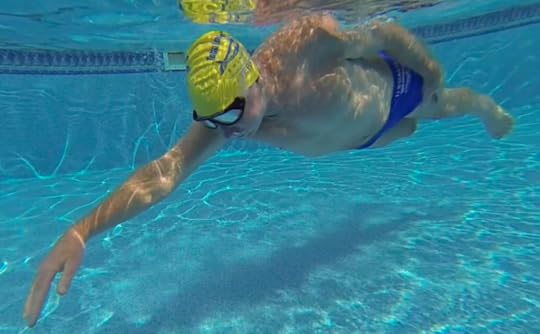
Over past couple weeks, we’ve shared excerpts from a companion instructional manual that Terry Laughlin created for T.I. workshop attendees, adapted from his 2006 book, “Extraordinary Swimming for Every Body.” The purpose of the supplementary material in this manual was to provide practical suggestions to guide T.I. swimmers through the first several weeks or months following a T.I. workshop (or after learning with T.I. self-teaching tools). This week’s post is another excerpt from that manual, focused on the first phase of Kaizen (Continuous Improvement) Training: Energy Conservation. In this article, Terry details the importance of spending time on balance, comfort, and relaxation. From this solid foundation, one can build a stable, fluid, and efficient stroke… and be well-positioned to then cultivate advanced stroke mastery, increase distance, and increase speed. We’ll go in-depth on those latter topics next week, when we’ll share another post in this continuing series of excerpts from Terry’s workshop manual on Kaizen Swimming. Enjoy… and Happy Laps!
SELECTED EXCERPT FROM:
“KAIZEN SWIMMING: HOW TO MAKE THE MOST OF YOUR TOTAL IMMERSION WORKSHOP”

This part of the Workshop Manual will guide you through the first several weeks or months of training after your T.I. workshop (or after beginning T.I. practice with self-teaching tools). Pages 136-164 of the T.I. book Extraordinary Swimming for Every Body (“ES4EB”) also includes detailed guidance on how to plan a Kaizen Training program for the long term. Here’s an overview of what do in the first few weeks or months of your T.I. practice.
PHASE I: ENERGY CONSERVATION
Every workshop alum (or self-taught T.I. swimmer) should devote at least 10 to 20 hrs of practice to balance, comfort, and relaxation. (Some swimmers have remained at this level for a year or two without stagnating.) Your goals are to eliminate discomfort and tension and develop basic habits of efficient, fluent movement. For many swimmers, drills are essential for this, but whole-stroke can be helpful too. The specific foundations you should form include:
(1) Make breathing routine so it doesn’t distract you while working on other foundations.
(2) Create effortless support or balance by imprinting a neutral head position and the right position on the “track” for your relaxed extended hand.
(3) Make long, “slippery” bodylines a habit by learning to “pierce the water” with your spearing arm and follow the “track” with your bodyline.
(4) Make whole-body propelling movements a habit.
TOOLS
30% Balance Drills to learn balance and imprint sleek bodylines
40% Switch Drills- Focus on minimizing drag and turbulence, and becoming “patient” in trapping water
20% Mindful Swimming (whole stroke with focal points) to transfer awareness gained in drills into whole stroke
10% Stroke Counting to measure your improvements in efficiency and compare the effectiveness of various focal points
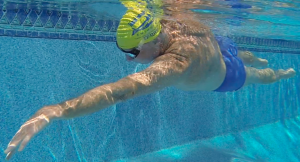
PRACTICE TIPS (for more guidance, read pgs. 115-135 of Extraordinary Swimming for Every Body)
Efficient, fluent swimming starts with exploring basic movements and positions with a sense of curiosity– and no sense of urgency. Whenever you feel discomfort during a drill, your natural reaction will be some kind of compensation– craning your neck, sculling, kicking too hard. These unconscious reactions imprint energy-wasting movements on our nervous system.
Patience in mastering basic skills may be natural to martial artists and dancers, but not to most swimmers. I only came to appreciate its value after a few years of regular yoga practice. The most beneficial goal for your first 10 to 20 hours of pool time following the workshop (or after first working with T.I. self-teaching tools) might be to make mindful, examined movement a habit. Don’t count laps or watch the pace clock; focus purely on sensation and awareness– aiming to reduce effort and increase flow. Your period of concentrated drill practice may last a few weeks for some students, several months for others. Your drill practice will benefit greatly if you follow these guidelines:
Short repeats. 25s or less for the first week or two, and seldom longer than 50s.
Short sets. To maintain acute attention, change your focus regularly. Alternate tasks that require intense focus, with less exacting ones.
Clear focus. Think about doing just one thing well on each length. Break it down finely. (e.g. on Switch Drills, you could divide your focal points into soft arms on recovery, recovering arm deep and slow, leading with your elbow, slicing your hand to your target, and tipping your fingers down.
Ignore the clock. Use “yoga breaths” to regulate your rest interval between repeats. 3 to 5 breaths should be sufficient.
* To continue reading about the progression of Kaizen Training, click here for the blog post on “Phase 2: Develop Your Stroke”
Advance beyond the basic T.I. skills with this comprehensive guide on pursuing the kaizen path of swimming to the highest levels of swimming mastery:
Terry Laughlin’s book– Extraordinary Swimming for Every Body– shows you how!

The post Kaizen Training: Priority #1– Conserve Energy appeared first on Total Immersion.
April 19, 2019
Conventional Training vs. Kaizen Training: Maximize the Value and Enjoyment of Your Practice
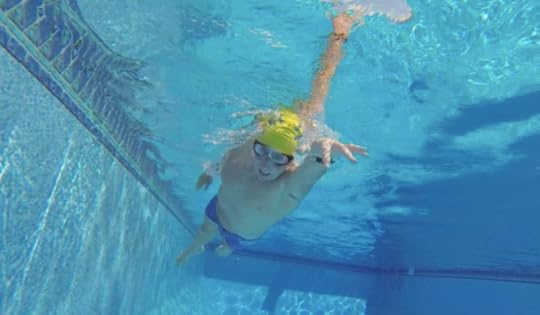
Last week we shared an excerpt from a companion instructional manual that Terry Laughlin created for T.I. workshop attendees, adapted from his 2006 book, “Extraordinary Swimming for Every Body.” The purpose of the supplementary material in this manual was to provide practical suggestions to guide T.I. swimmers through the first several weeks or months following a T.I. workshop (or after learning with T.I. self-teaching tools). Continuing in this vein, this week’s post is another concise excerpt from that manual and is focused on the shift in mindset as you get started with Kaizen (Continuous Improvement) Training, after learning the basics of T.I. fundamentals– and illustrates the contrasting benefits of pursuing a Kaizen Training approach instead of a traditional training approach. In the coming weeks, we’ll continue to share more excerpts from the manual on Kaizen Swimming, including the topics of energy conservation, and increasing mastery, distance, and speed. Enjoy… and Happy Laps!
SELECTED EXCERPT FROM:
“KAIZEN SWIMMING: HOW TO MAKE THE MOST OF YOUR TOTAL IMMERSION WORKSHOP”

KAIZEN EQUALS PLEASURE PRINCIPLE
I’ve emphasized that T.I. Swimmers have a very different mindset from most swimmers. Our paradigm for training is no less distinctive. Those training the T.I. way are not only improving steadily, but also enjoying it more than ever. In a few words, we believe in the pursuit of pleasure, rather than pain. This section provides guiding principles for maximizing the value– and enjoyment– of every hour you spend in the pool (or open water).
Expect improvement. Most adult swimmers have become resigned to swimming year after year with little to show for it. A T.I. Swimmer’s goal should be Kaizen (continuous improvement) Swimming. Because swimming offers limitless opportunities for solving the UHSP (Universal Human Swimming Problem) and increasing self-awareness, you could continue gaining in Mastery for decades. I still make exciting advances every year, and still sense almost limitless possibilities for further improvement. The refinements I’m making are fairly subtle, but my capacity for fine distinctions in position and timing has increased steadily. My current focus is on greater relaxation, especially when swimming faster.
CLEAR THINKING
There’s a great deal of “folklore” about swimming technique and training. One goal of T.I. instruction is to replace those misconceptions with clarity on how swimming works and to make that knowledge the basis for effective goal-setting. Since I entered my 50’s, I’ve begun every practice with two conscious intentions. Since I made this my practice– at an age when most swimmers are slowing down– my improvement not only continued, but accelerated.
Intention #1: My intention in every practice is to swim better than I ever have in my life. Setting the bar that high keenly concentrates one’s mind. Since I adopted that intention, I’ve enjoyed great fulfillment– and even excitement– in virtually every practice. A key to making this happen is to never push off a wall without a specific purpose.
Intention #2: My intention on every set and repeat is to accomplish whatever task I set for myself (whether technique, stroke count, time, or some combination) with as little effort as possible. In conventional training, the goal is typically to work harder, to increase physiological capacity. But time and energy are finite, while opportunities to increase efficiency are virtually infinite. After more than 40 years, I’m still improving my sense of how to swim more economically.
WHAT ABOUT FITNESS?
In writing about training, I don’t mean to suggest that fitness is unimportant. But instead of training to “get in better shape,” train to improve your swimming. Conditioning will be something that happens to you while you improve your swimming. To illustrate:
Redefine Endurance. Webster’s defines endurance as “the ability to sustain a prolonged stressful effort or activity.” T.I. defines Swimming Endurance as “the ability to repeat effective swimming movements for a duration and speed of your choosing.” That definition places as much importance on nervous system development as on aerobic system development. The critical difference is that when you train the nervous system, the aerobic system also receives the training it needs; when you train the aerobic system, there’s no guarantee that the nervous system will be trained the way you wish.
Ideal for Fitness Swimming. Many of those who take our workshops swim purely for fitness, rather than speed or performance. A common question among fitness swimmers is: “If I swim easier, will I lose fitness?” You won’t– and here’s why:
(1) A quality workout is one that makes good use of the body. T.I. practice makes better use of the body than conventional workouts, minimizing the chances of injury and increasing the likelihood that you’ll be able to do healthful training consistently.
(2) Motivation matters. If you enjoy and are engaged by your fitness routine, you’ll continue for the long term; if you don’t enjoy it, you’ll lose interest. Kaizen– Continued Improvement– Swimming will keep your interest higher than conventional training that you do simply because “it’s good for you.”
(3) Increasing intensity is always an option. Once you begin to master the basics of efficient T.I. swimming, you’ll find yourself able to swim longer– and faster– with less fatigue.
Should I Increase Yardage? In Kaizen Training, the primary reason for swimming more yards is to increase opportunities to imprint efficient movement. Will fitness increase as you do so? Yes, but your swimming will benefit only if that increased fitness accompanies increased skill. So if increased yardage causes you to compromise form, don’t swim those distances until you can do so and maintain good form.
Advance beyond the basic T.I. skills with this comprehensive guide on pursuing the kaizen path of swimming to the highest levels of swimming mastery:
Terry Laughlin’s book– Extraordinary Swimming for Every Body– shows you how!

The post Conventional Training vs. Kaizen Training: Maximize the Value and Enjoyment of Your Practice appeared first on Total Immersion.
Terry Laughlin's Blog
- Terry Laughlin's profile
- 17 followers




